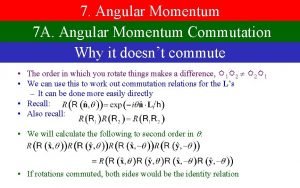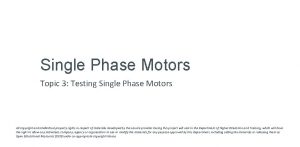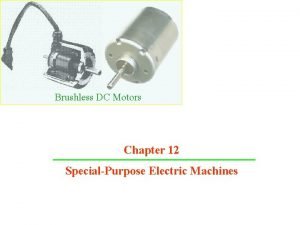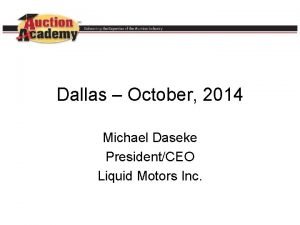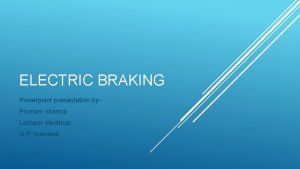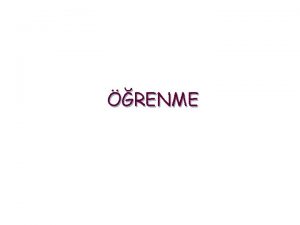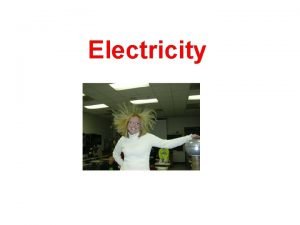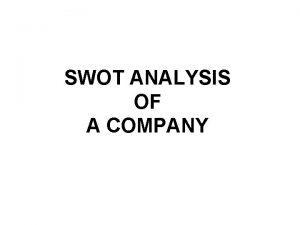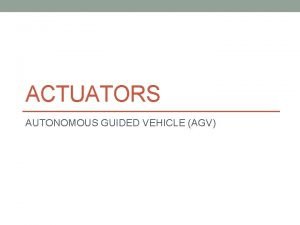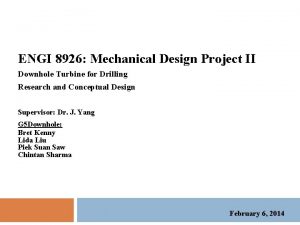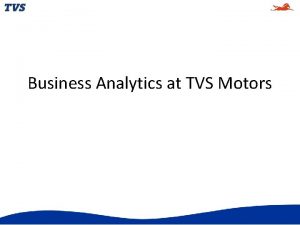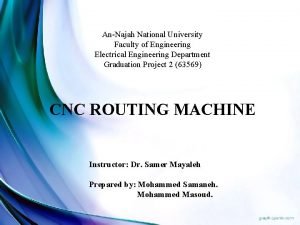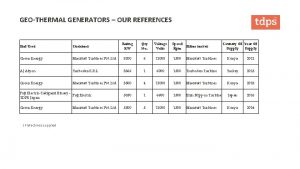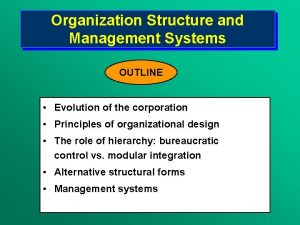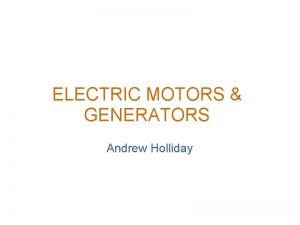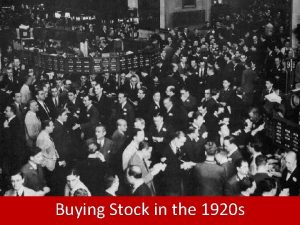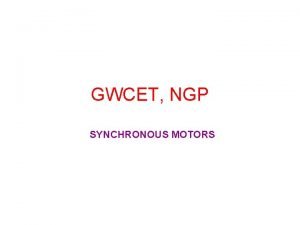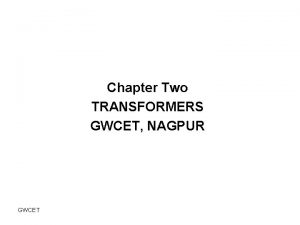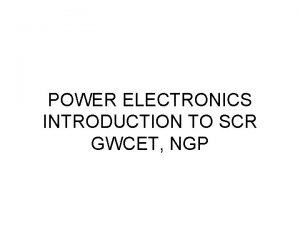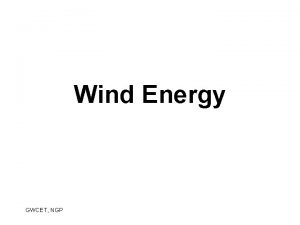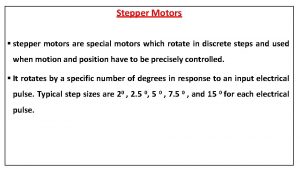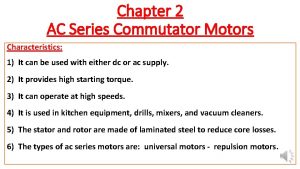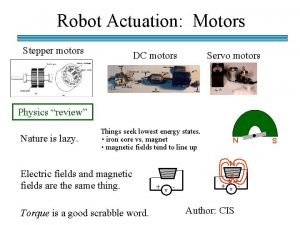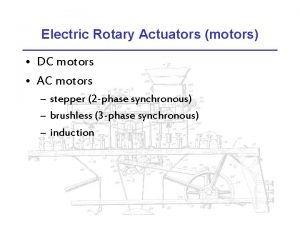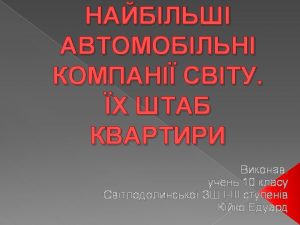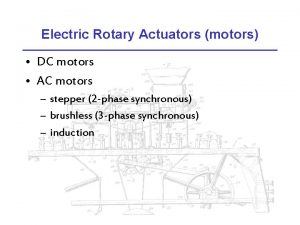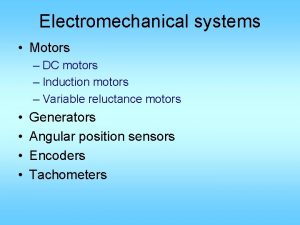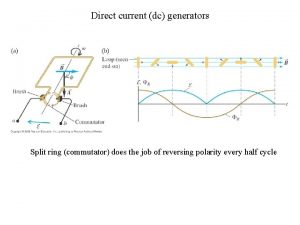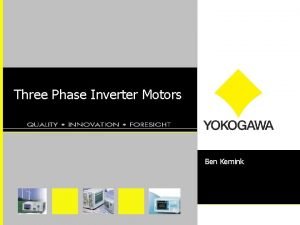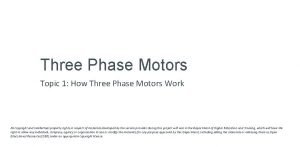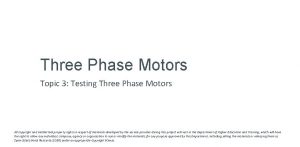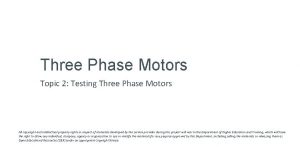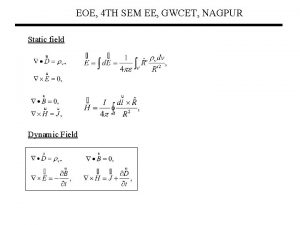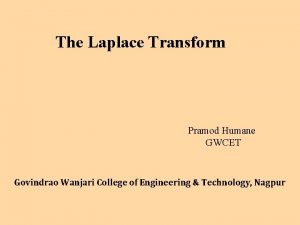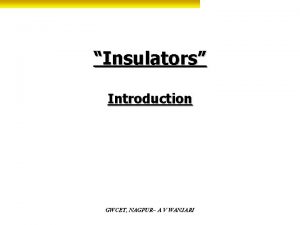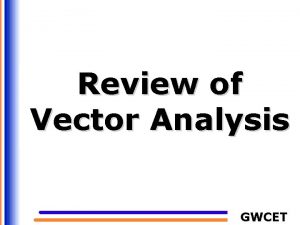SPECIAL MOTORS GWCET NGP Commutator motors 3 phase

































- Slides: 33

SPECIAL MOTORS GWCET, NGP

Commutator motors ü 3 phase induction motor-Not a variable speed motor ü 1 Phase induction motor-Not self starting, poor power factor, efficiency Common single phase commutator motors are 1. Series motors 2. Universal motors 3. Repulsion motors 4. Repulsion –induction motors

AC Series motors If we connect normal dc series motor to ac what happens? 1. Torque developed is not constant Magnitude 2. Alternating flux induce eddy currents causing heat and there by loss 3. No inductive coupling between armature and field since they are placed in quadrature 4. Sparking in brushes is more due to transformer emf induced 5. Due to large voltage drop speed reduced 6. Starting Torque is low, low pf

AC Series motors Modification needed for ac series motor. 1. To reduce eddy current loss-Laminations used 2. To reduce reactance-series field should contains less number of turns 3. To improve torque no. of armature conductors should be large 4. To reduce reactance compensating winding should be used 5. Operating voltage kept low to reduce inductance 6. Reduce frequency to reduce inductance 7. Interpoles to reduce armature resistance leads

Universal motors Construction Changes should be employed to work in both ac and dc

Universal motors Operation When motor is connected to an a. c. supply, the same alternating current flows through the field and armature windings. The field winding produces an alternating flux fhat reacts with the current flowing in the armature to produce a torque. Since both armature current and flux reverse simultaneously, the torque always acts in the same direction. It may be noted that no rotating flux is produced in this type of machines; the principle of operation is the same as that of a d. c. series motor.

Universal motors Characteristics The operating characteristics of an a. c. series motor are similar to those of a d. c. series motor. (i) The speed increases to a high value with a decrease in load. In very small series motors, the losses are usually large enough at no load that limit the speed to a definite value (1500 - 15, 000 r. p. m. ). (ii) The motor torque is high for large armature currents, thus giving a high starting torque. (iii) At full-load, the power factor is about 90%. However, at starting or when carrying an overload, the power factor is lower

Universal motors Applications The fractional horsepower a. c. series motors have high-speed (and corresponding small size) and large starting torque. They can, therefore, be used to drive: (a) high-speed vacuum cleaners (b) sewing machines (c) electric shavers (d) drills (e) machine tools etc.

Single-Phase Repulsion Motor A repulsion motor is similar to an a. c. series motor except that: (i) brushes are not connected to supply but are short-circuited - currents are induced in the armature conductors by transformer action. (ii) the field structure has non-salient pole construction. By adjusting the position of short-circuited brushes on the commutator, the starting torque can be developed in the motor

Single-Phase Repulsion Motor Construction The field of stator winding is wound like the main winding of a split-phase motor and is connected directly to a single-phase source. The armature or rotor is similar to a d. c. motor armature with drum type winding connected to a commutator However, the brushes are not connected to supply but are connected to each other or short-circuited. Short-circuiting the brushes effectively makes the rotor into a type of squirrel cage. The major difficulty with an ordinary single-phase induction motor is the low starting torque. It has also better power factor than the conventional single-phase motor.

Single-Phase Repulsion Motor Construction

Single-Phase Repulsion Motor Principle of operation listen to me…

Single-Phase Repulsion Motor The total armature torque in a repulsion motor can be shown to be Ta = sin 2α where α = angle between brush axis and stator field axis For maximum torque, 2α = 90° or α = 45° Thus adjusting α to 45° at starting, maximum torque can be obtained during the starting period. However, α has to be adjusted to give a suitable running speed.

Single-Phase Repulsion Motor Characteristics (i) The repulsion motor has characteristics very similar to those of an a. c. series motor i. e. , it has a high starting torque and a high speed at no load. (ii) The speed which the repulsion motor develops for any given load will depend upon the position of the brushes. (iii) In comparison with other single-phase motors, the repulsion motor has a high starring torque and relatively low starting current.

Repulsion-Start Induction-Run Motor Sometimes the action of a repulsion motor is combined with that of a single phase induction motor to produce repulsion-start induction-run motor (also called repulsion-start motor). The machine is started as a repulsion motor with a corresponding high starting torque. At some predetermined speed, a centrifugal device short-circuits the commutator so that the machine then operates as a single-phase induction motor.

Repulsion-Start Induction-Run Motor This motor has the same general construction of a repulsion motor. The only difference is that it is equipped with a centrifugal device fitted on the armature shaft. When the motor reaches 75% of its full pinning speed, the centrifugal device forces a short-circuiting ring to come in contact with the inner surface of the commutator. This short-circuits all the commutator bars. The rotor then resembles squirrel-cage type and the motor runs as a single-phase induction motor. At the same time, the centrifugal device raises the brushes from the commutator which reduces the wear of the brushes and commutator as well as makes the operation quiet.

Repulsion-Start Induction-Run Motor Characteristics (i) The starting torque is 2. 5 to 4. 5 times the full-load torque and the starting current is 3. 75 times the full-load value. (ii) Due to their high starting torque, repulsion-motors were used to operate devices such as refrigerators, pumps, compressors etc. However, they posed a serious problem of maintenance of brushes, commutator arid the centrifugal device.

Repulsion-Induction Motor The repulsion-induction motor produces a high starting torque entirely due to repulsion motor action. When running, it functions through a combination of induction-motor and repulsion motor action.

Repulsion-Induction Motor Construction It consists of a stator and a rotor (or armature). (i) The stator carries a single distributed winding fed from single-phase supply. (ii) The rotor is provided with two independent windings placed one inside the other. The inner winding is a squirrel-cage winding with rotor bars permanently short-circuited. Placed over the squirrel cage winding is a repulsion commutator armature winding. The repulsion winding is connected to a commutator on which ride short-circuited brushes. There is no centrifugal device and the repulsion winding functions at all times.

Repulsion-Induction Motor Operation (i) When single-phase supply is given to the stator winding, the repulsion winding (i. e. , outer winding) is active. Consequently, the motor starts as a repulsion motor with a corresponding high starting torque. (ii) As the motor speed increases, the current shifts from the outer to inner winding due to the decreasing impedance of the inner winding with increasing speed. Consequently, at running speed, the squirrel cage winding carries the greater part of rotor current. This shifting of repulsion motor action to induction-motor action is thus achieved without any switching arrangement.

Repulsion-Induction Motor Characteristics (i) The no-load speed of a repulsion-induction motor is somewhat above the synchronous speed because of the effect of repulsion winding. However, the speed at full-load is slightly less than the synchronous speed as in an induction motor. (ii) The speed regulation of the motor is about 6%. (iii) The starting torque is 2. 25 to 3 times the full-load torque; the lower value being for large motors. The starting current is 3 to 4 times the full-load current. This type of motor is used for applications requiring a high starting torque with essentially a constant running speed. The common sizes are 0. 25 to 5 H. P.

Single-Phase Synchronous Motors Very small single-phase motors have been developed which run at true synchronous speed. They do not require d. c. excitation for the rotor. Because of these characteristics, they are called unexcited single-phase synchronous motors. The most commonly used types are: (i) Reluctance motors (ii) Hysteresis motors The efficiency and torque-developing ability of these motors is low; The output of most of the commercial motors is only a few watts

Reluctance Motor It is a single-phase synchronous motor which does not require d. c. excitation to the rotor. Its operation is based upon the following principle: Whenever a piece of ferromagnetic material is located in a magnetic field; a force is exerted on the material, tending to align the material so that reluctance of the magnetic path that passes through the material is minimum.

Reluctance Motor Construction (i) a stator carrying a single-phase winding along with an auxiliary winding to produce a synchronous-revolving magnetic field. (ii) a squirrel-cage rotor having unsymmetrical magnetic construction. This is achieved by symmetrically removing some of the teeth from the squirrel cage rotor to produce salient poles on the rotor. The salient poles created on the rotor must be equal to the poles on the stator. Note that rotor salient poles offer low reluctance to the stator flux and, therefore, become strongly magnetized.

Reluctance Motor Operation (i) When single-phase stator having an auxiliary winding is energized, a synchronously-revolving field is produced. The motor starts as a standard squirrel-cage induction motor and will accelerate to near its synchronous speed. (ii) As the rotor approaches synchronous speed, the rotating stator flux will exert reluctance torque on the rotor poles tending to align the salient-pole axis with the axis of the rotating field. The rotor assumes a position where its salient poles lock with the poles of the revolving field (ii)) Consequently, the motor will continue to run at the speed of revolving flux i. e. , at the synchronous speed.

Reluctance Motor Operation (iii) When we apply a mechanical load, the rotor poles fall slightly behind the stator poles, while continuing to turn at synchronous speed. As the load on the motor is increased, the mechanical angle between the poles increases progressively. Nevertheless, magnetic attraction keeps the rotor locked to the rotating flux. If the load is increased beyond the amount under which the reluctance torque can maintain synchronous speed

Reluctance Motor Characteristics (i) These motors have poor torque, power factor and efficiency. (ii) These motors cannot accelerate high-inertia loads to synchronous speed. (iii) The pull-in and pull-out torques of such motors are weak. Despite the above drawbacks, the reluctance motor is cheaper than any other type of synchronous motor. They are widely used for constant-speed applications such as timing devices, signaling devices etc

Hysteresis Motor It is a single-phase motor whose operation depends upon the hysteresis effect i. e. , magnetization produced in a ferromagnetic material lags behind the magnetizing force.

Hysteresis Motor Construction (i) a stator designed to produce a synchronously-revolving field from a single-phase supply. This is accomplished by using permanent-split capacitor type construction. Consequently, both the windings (i. e. , starting as well as main winding) remain connected in the circuit during running operation as well as at starting. The value of capacitance is so adjusted as to result in a flux revolving at synchronous speed. (ii) a rotor consisting of a smooth cylinder of magnetically hard steel, without winding or teeth.

Hysteresis Motor Operation (i) When the stator is energized from a single-phase supply, a synchronously revolving field (assumed in anti-clockwise direction) is produced due to split-phase operation. (ii) The revolving stator flux magnetizes the rotor. Due to hysteresis effect, the axis of magnetization of rotor will lag behind the axis of stator field by hysteresis lag angle , the rotor and stator poles are locked. If the rotor is stationary, the starting torque produced is given by:

Hysteresis Motor Operation From now onwards, the rotor accelerates to synchronous speed with a uniform torque. (iii) After reaching synchronism, the motor continues to run at synchronous speed and adjusts its torque angle so as to develop the torque required by the load.

Hysteresis Motor Characteristics (i) A hysteresis motor can synchronize any load which it can accelerate, no matter how great the inertia. It is because the torque is uniform from standstill to synchronous speed. (ii) Since the rotor has no teeth or salient poles or winding, a hysteresis motor is inherently quiet and produces smooth rotation of the load. (iii) The rotor takes on the same number of poles as the stator field. Thus by changing the number of stator poles through pole-changing connections, we can get a set of synchronous speeds for the motor.

Hysteresis Motor Applications Due to their quiet operation and ability to drive high-inertia toads, hysteresis motors are particularly well suited for driving (i) electric clocks (ii) Timing devices (iii) tape-decks (iv)from-tables and other precision audio-equipment.
 Spherical harmonics formula
Spherical harmonics formula Ac theory 3 lesson 4
Ac theory 3 lesson 4 How to test a single phase motor
How to test a single phase motor Special purpose motors
Special purpose motors Broad phase vs narrow phase
Broad phase vs narrow phase Hplc reverse phase vs normal phase
Hplc reverse phase vs normal phase Line vs phase voltage
Line vs phase voltage Mobile phase and stationary phase
Mobile phase and stationary phase Adsorption chromatography
Adsorption chromatography Chromatography definition
Chromatography definition Phase to phase voltage
Phase to phase voltage Normal phase vs reverse phase chromatography
Normal phase vs reverse phase chromatography Normal phase vs reverse phase chromatography
Normal phase vs reverse phase chromatography Ebay motors
Ebay motors Advantages and disadvantages of plugging braking
Advantages and disadvantages of plugging braking Narayan motors
Narayan motors Spike prime download
Spike prime download Rol 1
Rol 1 Scott dc motors
Scott dc motors Motors
Motors How does a motor work
How does a motor work Swot analysis of spare parts company
Swot analysis of spare parts company Wasantha gunathunga
Wasantha gunathunga Agv stepper motors
Agv stepper motors Conclusion for project
Conclusion for project Selden motors
Selden motors Tvs advantage dms
Tvs advantage dms Annajah motors
Annajah motors Abb ability smart sensor
Abb ability smart sensor Maxwatt turbines pvt ltd
Maxwatt turbines pvt ltd General motors hierarchy
General motors hierarchy Holliday motors
Holliday motors General motors business model canvas
General motors business model canvas Tel-tone stock 1920
Tel-tone stock 1920
